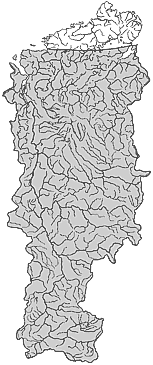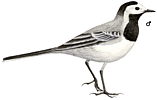|
|
| Main |
| Systematic List |
| Photo |
| Central Siberia |
| Guest book |
| Awards |
| SEARCH |
|---|
|
|
Motacillidae |
|---|
White Wagtail Motacilla alba Linnaeus, 1758
|
 The White Wagtail inhabits open landscapes and is ubiquitous in Central Siberia except in dense taiga forests and in polar deserts. It is commonly found on sand or pebble shores or on banks littered with fallen trees. In the Sayan Mountains, aside from inhabited settlements it also occurs on the shorelines of relatively large mountain rivers and of lakes, although it is generally quite rare at upper elevations. In the Minusinsk depression it is numerous in settlements and rare to common around water basins. The same is true of its distribution in forest-steppe and subtaiga. In Yenisey southern taiga, it is numerous in settlements (14-25 birds/km2) but rare along the Yenisey with only 0.6 birds/km2. Along the river, it is limited to rocky outcrops on the Yenisey Ridge. In the lower Kas River it is even rarer with 0.2 birds/km2 (Bursky and Vakhrushev 1983). In the southern part of Yenisey mid taiga, the species breeds in disturbed forestlands: on fresh pine clear-cuts, in piles of logs, and in slash and around stumps left on clear-cuts, besides the usual riverbanks and settlements. The population density here is generally greater along the Yenisey than near its taiga tributaries (Rogacheva et al. 1978). In Mirnoye, the numerous migrants first appear between April 25 and May 11; May 2 is the 11-year average. Migration continues throughout May and slows down only in the beginning of June. Migrants proceed only as far as weather conditions will allow; during cold spells, the birds engage in retromigrations. Flocks sometimes number up to 100 birds. The first arrivals forage on the Yenisey river ice near the banks. When the ice breaks, the birds move onto the first snow-free patches or to vernal pools in meadows near the station. In summer, foraging habitats include water edges, shorelines free of vegetation, and anthropogenic structures, roads and roofs. When the caddis fly adults saturate the environment, White Wagtails take to fly-catching around settlements. Depending on the food supply, the species is numerous in the Yenisey settlements and on riverbanks where it occurrs preferentially on gently sloping shorelines free of vegetation and breeds in densities of 50-60 birds/km2 and 4-12 birds/5 km of Yenisey shoreline, respectively. Around Mirnoye it averages only slightly more than 1 bird/km2. Again, commonly occupied habitats include the sand or pebble shorelines of rivers medium-sized or smaller, fresh clear-cuts in the southern part of the subzone, and recent severe burns where the birds feed on the singed soil surface and the burnt trunks. High spring floods that do not run off well can alter the species' breeding pattern. For example, in the flood year 1983, the entire breeding population in the Varlamovka River basin concentrated itself on burns lining the river banks, while the Yenisey population, where the water level was higher than it had been in many years, settled in piles of logs deposited in the upper floodplain. It is possible that the nests were already built by the time the floodwaters receded, in which case the adults must have traversed the entire floodplain forest many times a day to reach foraging sites in the shallows or on logs floating in the floodplain oxbow lakes. Normally, though, nesting never occurred beyond the floodplain limits. Of 20 nests examined, 8 were found around buildings: under eaves and roofing or even on a shelf in an abandoned hut. Five were scattered in flotsam deposited by the river — under logs, boards, in a pile of stones, and under a thoroughly rusted cast-iron pan. Five others were located farther up in hollows in steep river banks tucked under overhanging sod. Finally, two nests were found on clear-cuts, one inside a pile of logs and the other in a pile of dried branches. The White Wagtail nests found were strong and firm, made of small willow twigs and grass with inclusions of moss. The lining was thick and usually consisted of dog hair, chicken feathers, moose hair, and occasionally of thin grass stems and cotton. Of 12 complete clutches, 8 contained 5 eggs, one contained 4, and 3 contained 6 eggs. The earliest clutch was started on May 31, 1985; the other 8 clutches were begun in the first two thirds of June — the last one on June 18. One clutch was abandoned; two others were cleaned out by a stoat. One adult female, after abandoning her own clutch presumably as a result of losing her mate, actively fed a neighbouring brood. By the second half of July, the wagtails abandon the breeding areas but remain along the Yenisey banks until the beginning of August when migration starts. The birds follow the river south, and sometimes they are so numerous that small flocks of 5-10 birds pass along the river almost continuously. Occasionally, the flocks fly over taiga. After August 28, the Evenkian subspecies (M. a. ocularis) joins the much more common West Siberian subspecies (M. a. dukhunensis). During the first half of September, M. a. ocularis can comprise as much as 25% of all the White Wagtails caught for ringing. Migratory birds feed in the settlement, on mown hayfields, and along riverbanks. By the middle of September, the species has cleared out of the Varlamovka River valley and instead moves down to the Yenisey. Small numbers remain in Mirnoye until September 21-October 10. Finally, in Yenisey northern taiga, the White Wagtail is common along water basin edges (1.5-2 birds/km2) and numerous in inhabited settlements (Rogacheva and Vakhrushev 1983). It breeds only locally in the forest-tundra but is numerous on the river flats along the Yenisey from which it only rarely ventures into the habitats characteristic of this zone. At the Yenisey estuary (70° N) 100-126 birds/km2 breed in settlements in the shrub tundra subzone, while it is only common along the river itself (Ravkin and Gleich 1981). Suitable habitats in the Putorana Mountains also host populations considered common. A.V. Krechmar found that the species nested exclusively near inhabited areas further north, generally any place there are people north of typical tundra (Krechmar 1966). Apparently, they will follow them even into polar deserts, for example, at Cape Chelyuskin at 77°43' N (Chernov et al. 1979). The most northern natural nesting sites — i.e., in wind-protected stream valleys or with an accessible high water line on seasides or riverbanks — were registered on the lower Lenivaya River, on the lower Nizhnyaya Taymyra River, and along Maria Pronchishcheva Bay around 75° 16'-75°20' N (Vronsky 1986; Dorogov and Kokorev 1981). It is possible that the species also nests near inhabited settlements on the Severnaya Zemlya Archipelago (at approximately 80° N): for at the beginning of October 1983, a juvenile remained on a rubbish heap near one of the houses on Oktyabrskoy Revolutsii Island at the Cape of Vatutin for several days (Belikov and Randla 1987). |
[Back] |
|
|
|
|
Сайт разработан и поддерживается кафедрой прикладной экологии и ресурсоведения СФУ
